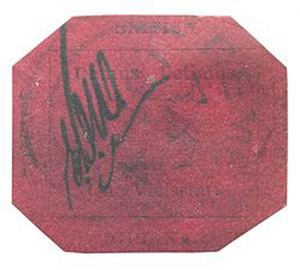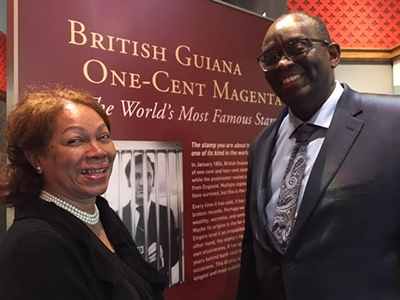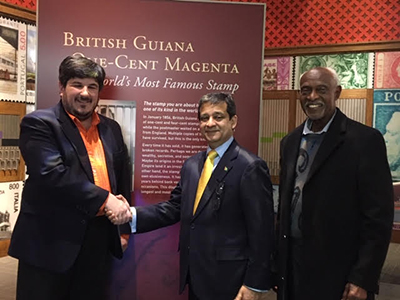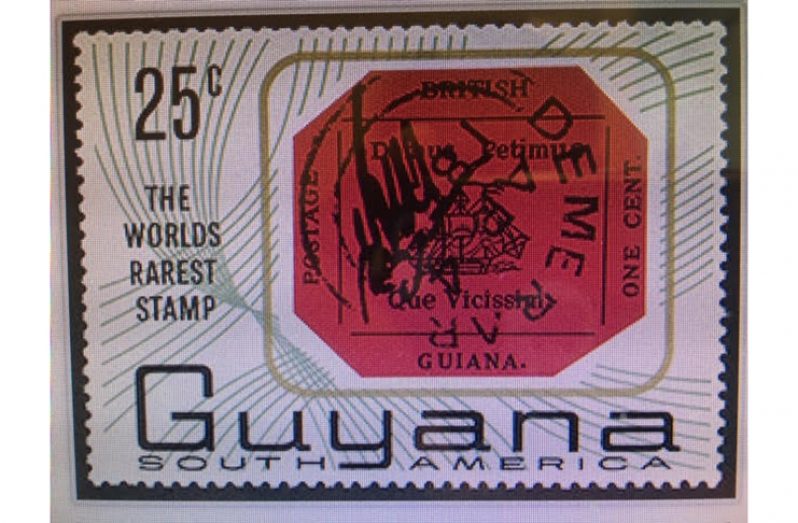By Francis Quamina Farrier
THIS is my third Feature Article about the World Famous British Guiana One-Cent Magenta Postage Stamp which is on a special Exhibition at the Smithsonian American Postal Museum in Washington, DC. The three-year-long exhibition at the Museum should have ended last Sunday, but due to the many persons, Guyanese included, who have been going to the museum to view it, a request was made to the owner, Stuart Weitzman, for an extension.

Weitzman agreed and so the iconic One-Cent Magenta will remain on exhibition at the Smithsonian American Postal Museum, for an indefinite period. That is great news for Guyanese who are residing in Washington, DC, Maryland and Virginia, as well as those who plan to visit the Capital of the USA sometime soon. Going to have a view of this historic stamp is worth it – and it’s free. The museum is located just next to the popular Union Station.
The iconic postage stamp now valued at US$9,480,000, was printed in British Guiana (now Guyana), at a Printing Facility on Church Street, Georgetown just east of the National Library, in 1856. The Printing Press on which it was printed, still exists and is on display on the ground floor of the National Library on North Road Georgetown, opposite the General Post Office.
During the exhibition of the stamp at the Smithsonian American Postal Museum in Washington, DC, quite a number of Guyanese have gone to view it. Those who have done so when I was also present include Guyana’s Ambassador to the USA and the OAS, Dr. Riyad Insanally, Guyana’s Ambassador to South Africa, Dr. Kenrick Hunte and his wife Claire, President and CEO of Federal Management Systems, Inc., Aubrey Stephenson, Capt. Beverley Drake, who is one of the very few living Guyanese whose image is on a postage stamp, Clare Murray who worked at the Philately Section of the General Post Office (GPO) in Georgetown for many years, Lawrence Lachmansingh and his family, Radio Technician Shamier Ali, Zena Stoll of Grant Enterprise on the Pomeroon, USA-based Valarie Charles and my daughter Arlene.

Regarded by many philatelists as the world’s most famous stamp, the Magenta has spent most of its 162 years away from public view. The current display at the Smithsonian American Postal Museum is the longest. There were just two interruptions when it was taken to Stamp Exhibitions in New York City and The Kingdom of Monaco in Europe. Tens of thousands of persons have seen this unique stamp and while there were two instances when individuals tried to present bogus copies, there was the signature of the Post Master General (PMG) of British Guiana on the real stamp, which verifies that it is the genuine Magenta, and exposed the attempted scams.

Throughout the 20th century and into the 21st century, there has been extreme security for this stamp reducing almost to zero, any possibility of it being stolen. There is also that saying, “Don’t even think about it”, because to steal something which is the only one on the planet, is an exercise in futility, since Interpol and all the international crime fighters, will be on the look-out and would nab the scoundrel or scoundrels in a jiffy. So any such thought should be dispelled immediately since it would be absolutely foolhardy to attempt such a stunt.
While the British Guiana One-Cent Magenta Stamp with origins in a “lowly” English-speaking country in South America on April 4, 1856, it has played a most important role in the Second World War, having been sold to pay off German war reparations. That stamp has always been in great demand by wealthy stamp collectors, including Queen Elizabeth ll, who failed in her attempt to buy the stamp. Over the years it has been owned by a few very wealthy individuals and was the centre of some highly dramatic issues, including a fiercely contested will.
The British Guiana One-Cent Magenta Stamp, which is listed as one of the International Treasures of the World, and which is now at the Smithsonian American Postal Museum in Washington, DC, may yet be taken to other cities for special brief exhibitions; cities with strong security and honest populations.



.jpg)








